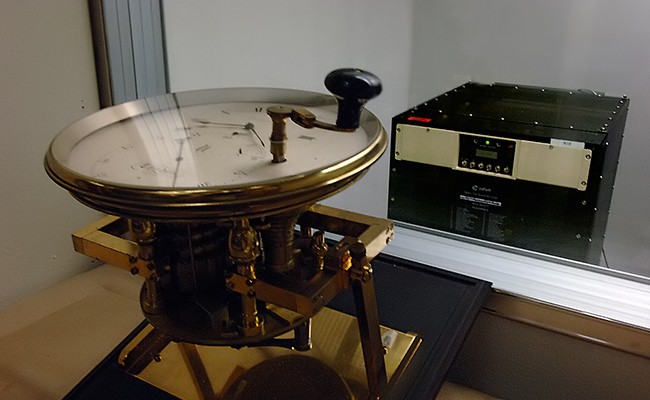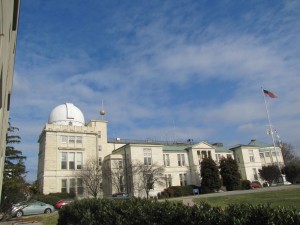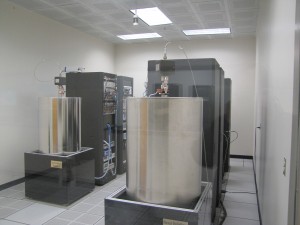To provide precise global time, critical to our digital world, the United States Naval Observatory serves as the major node in a worldwide array of synchronized atomic clocks.
For all but a relatively few astronomers and scientists, the universe of humans centers around our earthbound activities and our heuristic sense of time – day, night, seasons, hours minutes, and seconds. These tangible conventions and machinations of time – sun, moon, and stars — had served humankind well for millennia. But now in the digital age, our lives very much depend on (even if we do not realize it), precise time – precise almost to the point of abstraction. Digital networks, precise navigation, transportation systems, computing, cellular networks, and the booming internet of things (IoT) are dancing to the beat of a global clock – precise to billionths of a second.
Time and Sails.
Prior to time being utilized to determine longitude for global maritime commerce (and wars) and later to prevent collisions through tight scheduling for rapidly expanding rail systems, there was no compelling need for a globally synchronized time standard. During the era that such time-enabled navigation was developed, Britannia truly did rule the waves and established the prime meridian of this new navigation system at Greenwich Observatory, along with an official time standard (derived through astronomic observations in those days) that would become Greenwich Mean Time (GMT) – the roots of which have extended to the various subsequent time standards.
While precise timing activities are no longer performed at the Greenwich Observatory (this is now done for the UK at laboratories in the English midlands), the navigation and time meridian remains. Greenwich is a fascinating place to visit and a must see for geospatial practitioners, aficionados, and the general public (who love to pose for photos straddling the meridian line). There are still official clocks (timed from offsite sources) but those are mainly for historic and symbolic purposes. The mechanism for delivering standard time changed completely with the advent of radio and later satellites, but prior to the 20th century a great many methods for keeping time were utilized: sundials, astronomic observations, zenith cameras/tubes, spring and pendulum clocks. Time transfer was a further challenge; everywhere within earshot of a cathedral or town square clock could roughly keep in step. Cannon shots were one way to notify the whole fleet in harbor, but only inasmuch as the sound delay over distance could be accounted for. Time balls, like those at Greenwich, the US Naval Observatory (USNO), and major harbors around the world, were visible by ships in the harbor and could set their on-board clocks as the ball was dropped (typically at noon). A tribute to traditional time balls comes each New Year’s Eve in Times Square.
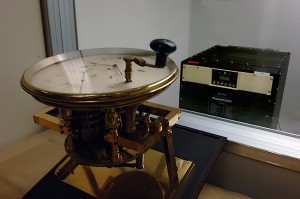
This Cummins clock (foreground), state of the art in the mid 19th century would have cost about the same as one of Hydrogen Maser clocks in the master clock array (background) but was about one billionth as precise. Current USNO clocks are precise to about 100 trillionth of a second per day.
Telegraphs to Atoms
Later, the era of telegraphy brought the first electronic method for time transfer in the US. Western Union rail station clocks could be synchronized via telegraph, as well as local observatories and even geodetic survey crews seeking to determine longitude more precisely than ever before. The US Naval Observatory had been the official keeper of time- responsible for both determination and dissemination — for the US since the mid-19th century, and by the mid-20th century, the USNO hosted its first atomic clock, and now it hosts around a hundred – the world’s largest single array of such clocks.
It is generally recognized that the predominant mechanism for global distribution of standardized precise time for our digital world is via the GPS constellation. While it should be noted that these myriad end-uses do not run on GPS Time (which is a continuum for its own global navigation purposes) offsets between GPS Time universal time standards are computed, updated, and transmitted; this enables, for instance, any computer network in the world to be able to work in synchronized global time (to nanoseconds) utilizing simple and inexpensive GPS receivers and antennas. We recently visited the USNO and spoke with Ed Powers, Division Chief for GPS Operations and Time Transfer.
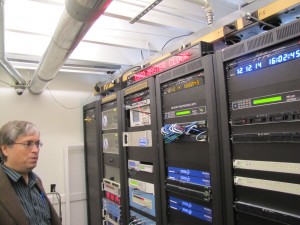
USNO’s Ed Powers with the Master Clock, which he explains is actually an array of around 100 atomic clocks.
Ed Powers likes to put the current atomic wizardry into context as he gives a tour of the USNO. He points to a small building adjacent to one of the observatory domes “those two pillars [on either side] hosted the PZT [photographic zenith tube] and the transit circle telescope, both now retired. The transit circle telescope is on display in the middle of the lobby of our main building 1.” Powers adds, “They were used to make time, but also serve are a geodetic reference – many western states’ borders are references to this pillars.” As the tour continued we saw two mid-size telescopes still in operational use at USNO – 26 and 27 inches. The historical 26-inch telescope was used for finding the moons of Mars and is still used today for identifying double stars. It is the oldest piece of operational gear in the US Navy. A smaller 12-inch telescope on the roof dome of building one, is now primarily used for tours.
Note that prior to electronic time transfer, getting precise time to the astronomers in the two main observatories on the campus took a little ingenuity. “There were a series of mirrors along a path through those windows above the doors, and the astronomer could see the clock in the other building,” Powers explained. The USNO was moved from the original location along the Potomac (established as the Depot of Charts and Instruments in 1830) to its present location in 1893 “to be away from the city lights of DC, for better astronomic observations” but grins as he points to the DC sprawl that has spread far beyond the site since. The history associated with the USNO, precise timing, and time-enabled navigation is very rich and could cover several future full features (count on it).
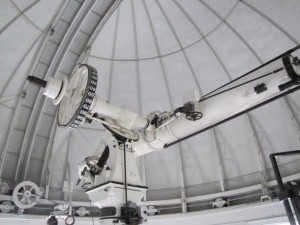
The historical 26-inch telescope was used for finding the moons of Mars and is still used today for identifying double stars. It is the oldest piece of operational gear in the US Navy.
A mix of old and new buildings, the USNO is a stately campus that sits atop Observatory Hill a few miles northwest of the Capital. The dome of one of the two remaining optical observatories sits atop the main administration building (and library); the other observatory, a standalone dome across, houses a 12-inch telescope that is the longest continuously operating government scientific instrument in the US. Visitors to the observatory are often taken by surprise when the entire floor raises and lowers — a unique solution to providing access to the telescope without having to scale ladders in the dark. A secure site, the former commander’s residence is now the official residence for the Vice President, and a number of embassies ring the hill. Powers leads us to a rather non-descript block building festooned with dozens of GNSS antennas – this is where the master clock, and most of the array of supporting atomic clocks, reside.
Time Lords
“The master clock is not a single clock,” said Powers. “It is really about a hundred clocks of different types here at USNO.” The first atomic clocks were ammonia maser, and the majority since are beam-type clocks; caesium is quite common. There are many types of atomic clocks, and a shorthand way to picture how they work is that two states of an oscillating atom are compared, and those states are induced by methods that often employ lasers and microwave chambers. The high oscillation rates of certain atoms enables minute units of time. In fact, the International System of Units defines a second (SI) as 9,192,631,770 cycles of radiation in transition between energy levels of a caesium atom. Powers showed racks holding scores of caesium beam type clocks, and in a new building nearby, several caesium fountain clocks, and some of the latest generation clocks: rubidium fountain.
Rubidium Fountain Clock
Fountain-style atomic clocks are an improvement over the legacy beam style clocks in that the atoms can be observed for a longer period. The Rubidium Fountain clocks designed and built by the USNO improve on caesium fountains in that rubidium can provide more stability and a gain in precision of as much as 300 pico-seconds. Lasers are used to slow rubidium atoms and more lasers push the atoms upward into a microwave cavity surrounded by four magnetic shields. The chamber is super-cooled – within about a degree of absolute zero – the slowed atoms rise and fall with gravity. This gives an increased hang time for the atoms and a longer observation period in which to compare the atoms in two power states. These clocks are the most precise possible at this time. Ed Powers explained that fountain clock operation is dependent on a very precise determination of gravity, specific to the installation of each individual clock. “If the clock were to be raised or lowered even a meter,” says Powers, “the gravity values would change.” The Auxiliary Master Clock is kept in Colorado Springs, co-located with the GPS Master Control Station.
Coordinated Universal Time
It might not be a surprise to those in the positioning and measurement communities that there is more than one flavor of “time”; after all, we are used to dealing with multiple units; meters, at least two kinds of “feet” – and how many “North’s” can you count?
Multiple clocks yield modeled time far more precise than any individual clock; the USNO clocks are used in this manner, and are compared with international array of over 300 clocks to determine International Atomic Time (TAI) tracking time on the rotating surface of the earth’s geoid (this is a way to account for any relativistic effects of varied gravity and distance from the earth’s center). See the chart at the article footer for an example of UTC, or Coordinated Universal Time, which is divided into days, minutes, and seconds, and as each day is divided into exactly 86,400 of the SI (standard seconds mentioned earlier), leap seconds are added to TAI. TAI and UTC are estimated by the laboratories of the international clock array, and later time is observed by these laboratories. The predicted and locally observed time are compared and results published; valuable data for precise timing practitioners in identifying anomalies or errors in their own clock data products. UTC is actually comprised of 3 variants; UT0, UT1, and UT2, all operating within 50 milliseconds of each other (but we better save that for another article).
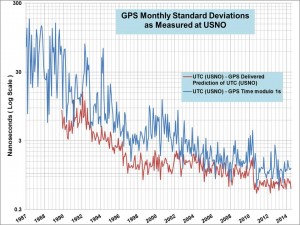
The USNO not only provides the time offsets for GPS operations, but also monitors the time being transferred by the satellite constellation. Predicted and observed time are compared (as shown in this graph). Note the dramatic improvement since the early days of GPS. Such advances have benefitted not only the precise timing community, but have improved the overall precision of GPS across the board.
Powers’ team is responsible for providing the clock offsets to GPS operations to be uploaded into the satellites, and also tracks time as delivered by the satellites. The precision of the clock component of the GPS system has improved dramatically since the late ’80s; from tens of nanoseconds to one or two – this has improved alternate GPS positioning methods like real-time precise-point-positioning (PPP-RT) to begin to rival RTK. There are other time transfer services provided by the USNO: an internet time server, and telephone based time transfer. NIST is a partner with USNO in keeping time for the United States. The National Institute of Standards and Technology (NIST); formerly National Bureau of Standards (NBS) broadcasts radio timing signals from its Fort Collins Colorado facility (as WWVB since 1965). USNO has experimented with other time transfer technologies, including the ground based locked-time-loop system built by Locata (see “It’s About Time”, September 2014 xyHt). The initial Locata test was performed across the roof of a USNO building, and the results were in the range of hundreds of pico-seconds, a promising first test. Powers is looking to try it over a longer distance and is eyeing some buildings within view of the USNO for further tests. (Powers notes that this has now been done since our visit.) Time transfers via satellite and even fiber optics have their challenges, and now that the clocks are producing more precise time, new ways of transferring time are being explored.
Slowing Down but Moving Forward
“The earth is not a very good clock,” says Powers. UTC is tied to the earth and earth rotation and, adds Powers, “The rotation has inconsistencies due to tidal influences, and the earth’s rotation is slowing.” This is why there are those leaps seconds that bedevil GPS users. Leap seconds can be applied on June 30th or December 31st, and happens every few years. Earth-based time serves certain needs well, but there are compelling arguments that it does not serve the vast majority of downstream timing users well. “The ITU (International Telecommunications Union) has had some serious discussions about doing away with leap seconds,” said Powers. “There is no consensus yet, but it will be brought up again in November [2015 at the World radio Conference].”
Services like GPS get taken for granted, likewise with precise timing. There are dedicated folks like Powers and the other scientists at the USNO, and worldwide that keep the worlds clocks running. And these folks are continually thinking up amazing new ways to deliver even more precise time. Little of the magic driving your digital world is possible without precise time – so next time you are binge watching something on your favorite streaming site, or firing up your GPS receiver, take a second (no pun intended), and think about that hill in Washington DC where the atomic time lords make it all happen.
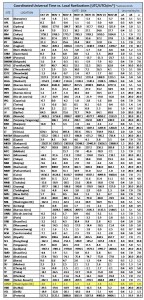 [left – click to expand] – official circulars show comparisons between predicted and observed time from the international array of atomic clocks that determine and deliver precise time. This example (that xyHt has been put into table format for this article) was derived from: CIRCULAR T 323 ISSN 1143-1393 – 2014 DECEMBER 09, 09h UTC BUREAU INTERNATIONAL DES POIDS ET MESURESORGANISATION INTERGOUVERNEMENTALE DE LA CONVENTION DU METRE
[left – click to expand] – official circulars show comparisons between predicted and observed time from the international array of atomic clocks that determine and deliver precise time. This example (that xyHt has been put into table format for this article) was derived from: CIRCULAR T 323 ISSN 1143-1393 – 2014 DECEMBER 09, 09h UTC BUREAU INTERNATIONAL DES POIDS ET MESURESORGANISATION INTERGOUVERNEMENTALE DE LA CONVENTION DU METRE

